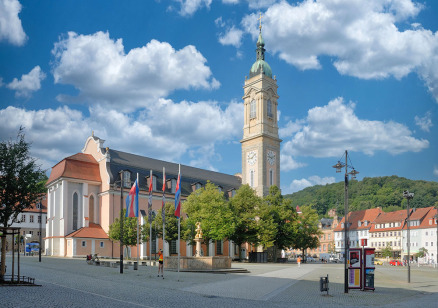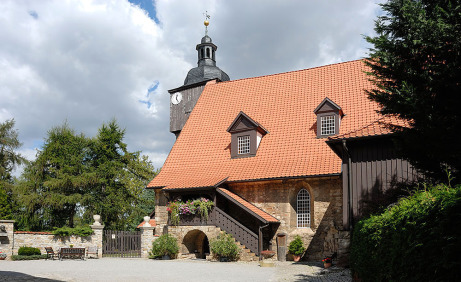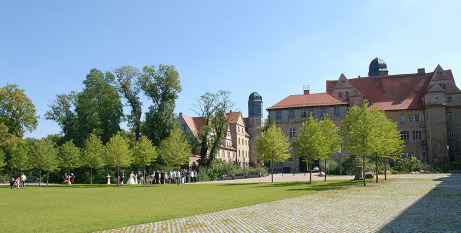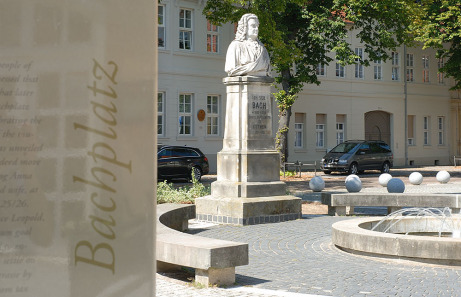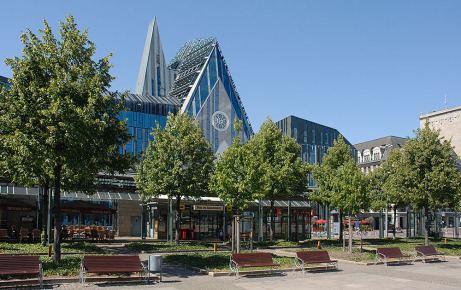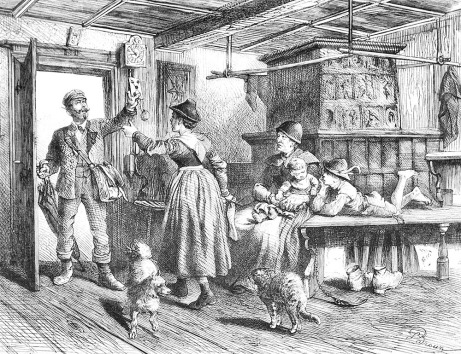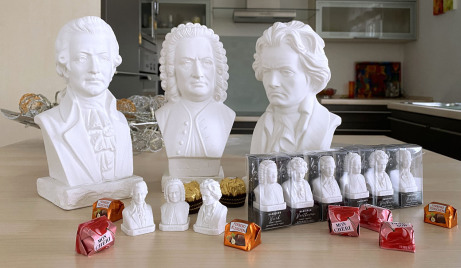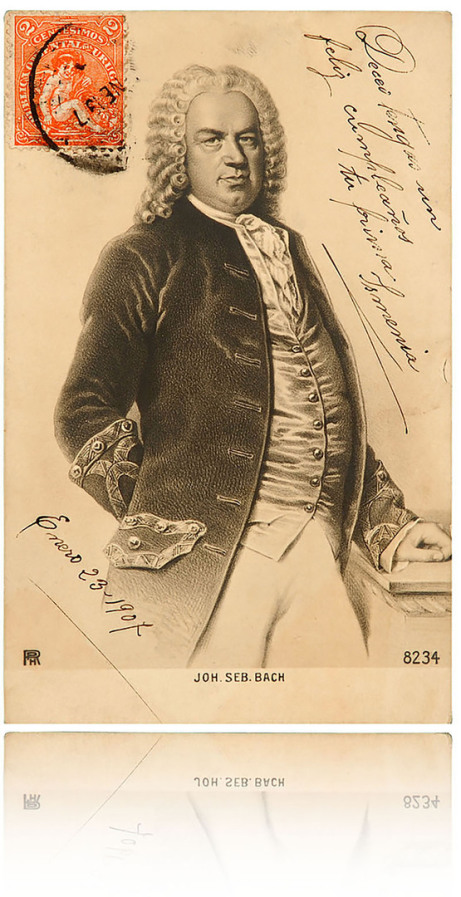The Johann Sebastian Bach Short Biography: The Most Famous Composer of All Time
Johann Sebastian Bach is the musician who prompted 700 Bach biographers to write a detailed biography about him. And then there are the Bach fans who have written countless short biographies about the composer.
The Bach short biography to read. This is what awaits you on this of two entertaining pages about the composer in your language. The link at the end of the paragraph will take you to my Bach video short biography in your language. And I will also guide you through my "Bach on Bach" Project in your language. Please click here.
Would you like to help me with your corrections? Then, please read the sections at the bottom of the overview page (... the one with the flags). And next? Please contact me first: Send an e-mail to "peter [at] bachueberbach.de". And read on here before you send me this mail. Thank you very much. Click here to get to this page with the flags.
Countless authors have written a short biography about Bach. And I alone can provide you with the Bach short biography in around 50 versions. With a smile, of course. These are the ones you are reading right now, in 20 languages, six more with different lengths, in both German and English ... to read. And there is also a short Bach video biography, also in 20 languages. So ... am I the author who has written the most Bach short biographies? I certainly am. I'm also the Bach funny maker, and that's not a grammatical error. It's a historical expression. Because I am not a comedian.
By the way, did you know that there are dozens of portraits of the Thuringian superstar? Only one is authentic: It is the painting above, created by Elias Gottlob Haußmann in 1747, three years before our master's death. All the other portraits are pure fantasy ... what Bach might have looked like back then.
A quick question here and now: Would you prefer to watch the short biography of Bach as an exciting nine-minute long video first? Or would you first like to find out more about my large, international Bach Project? If you rather want to read the short biography, then stay on this page. If the video alternative sounds exciting to you, then please click at the bottom of this page. Or simply click here.
What is that up there? Find out more about the detailed history of the Bach Seal with my Bach Project. And there is even a short version here in your language. On page 1.
Have you researched and found this, my website about Johann Sebastian Bach, among the first results on Google page 1? I would like to point out that this is my 3rd section – in your language – on the largest international and largest German website about the genius from Eisenach in Thuringia in Germany.
Section No. 1 is a nine-minute short video. It is the short video biography about Bach's life journey. This video is also available in your native language. The link above will take you to this page 1.
Section No. 2 is lots and lots of information about the Bach Project by a member of the world's largest family of musicians ... that's me, Peter Bach Jr., also one of the two spokesmen of the family. Keywords for the content of this first of two pages are: Bach cities and Bach places, Bach monuments, Bach stamps, Bach's music, Bach trips, the Bach genealogy and more. Believe it or not, the Bach Seal above is the "real, true" Bach Sign or Bach Monogram, which was only found in 2009. That is, when it was realized that it was the "real" one. The black and white, famous ( ! ) seal was then changed: The number of points in the crown was reduced from seven to just five. You can read more about this via the link to page 1 above.
The Short Biography About the Greatest Composer on Earth, Johann Seabstian Bach as Reading Material
Wechmar ... Where the Bach Story Began
The ancestry of the Bach family of musicians – the largest musical family in the world and of all time – is really complicated. Bach experts still argue about whether the Bache, as they were called at the time, came from Hungary or from a place called Ungern or a region in Bohemia with that name. After their return from abroad, one Bach after another made music. For a long time, almost all the male Bachs in this family did.
Very important for the genealogy of the Bach family of musicians: the Bach village of Wechmar, a small community in Thuringia. This is the place where the first Bach made music: It was Veit Bach, the great-great-grandfather of Johann Sebastian Bach. The Bach ancestral home (... Bach-Stammhaus) can be seen in the picture above. Veit Bach and his son, Hans the minstrel (... Hans, der Spielmann), baked there.
The Veit Bach mill in Wechmar ... It was almost demolished. This is where Veit and Hans ground their grain. This mill is mentioned in the famous list of more than 50 Bach musicians compiled by Johann Sebastian Bach in 1735.
Eisenach, Thuringia, Germany
The world-famous castle "Wartburg". It is the landmark of the nearby town of Eisenach.
Wartburg Castle became famous because Martin Luther spent around ten months here when he was ostracized. Martin Luther lived there as "Junker Jörg". During this time, he translated the New Testament from Greek into German. In the process, he is said to have thrown his inkwell at the devil. Since the era of tourism began and visitors touched the stain and even scratched small pieces to take home with them, the stain on the wall has been refreshed from time to time. In the meantime, more than 100 years ago, the stain was no longer renewed.
Eisenach: what a beautiful town, rich in so many historical treasures that are well worth a visit. Above, you can see St. George's Church, where Bach was baptized in 1685.
Johann Sebastian Bach was born in Eisenach on March 21 and ( ?! ) on March 31, 1685, the eighth child of eight children. His father was Johann Ambrosius Bach and his mother was Maria Elisabeth Lämmerhirt. Both were musicians.
Rich in historic buildings, monuments and fountains: the Bach town of Eisenach, Thuringia, Germany.
The Bachhaus (... Bach House), on the left, and the ultra-modern Bach Museum next to it. Very small, between the two trees: the Bach memorial. I have produced a short video about this Bachhaus for my website visitors and for Bach fans, including future Bach fans. Unfortunately, you can only enjoy it in German or English. Sorry. Here you get there.
The Johann Sebastian Bach Monument, right next to the Bach House and the Bach Museum.
The Bach House at Eisenach back then.
Today, we know that the actual birthplace of Johann Sebastian Bach was about 27 seconds* walk east of the Bach House. It was located roughly halfway, so to speak, between today's Bach House and St. George's Church in Eisenach* ... with a wink.
Wait a minute, how can someone have been born on two days in one month? And it has to be an "or", not an "and". It depends on which calendar you use. At that time, there was already the Julian calendar and still the Gregorian calendar. However, this was just about to change in Thuringia when Johann Sebastian was born. Scientists therefore argued for decades about which date was the correct one for Bach's birth. The whole world eventually switched from the Gregorian to the Julian calendar, and it took 330 years for the last country to "join the club". It was later agreed that March 21 was the date of Bach's birth.
Johann Sebastian's mother died when he was nine years old. His father quickly remarried. Shortly afterwards, his father's brother died. And as the two brothers seemed to love each other dearly, this was too much pain for Bach's father ... He also died. It is said that Johann Sebastian was a very poor student at this time and missed many hours and days at school. Other biographers state that the reason for this was that he was needed by his father to support the family and perform as a brilliant singer, while his father made the music at parties and weddings.
Johann Sebastian in Ohrdruf
The lovely Bach town of Ohrdruf, the residence of Johann Sebastian’s oldest brother.
The beautiful palace at Ohrdruf.
Only the tower of St. Michael's Church in Ohrdruf survived World War II. The nave was never rebuilt. Johann Sebastian Bach's eldest brother was the organist in this church.
After Johann Sebastian's mother and father died, he moved in with his eldest brother in Ohrdruf. Johann Christoph Bach was a teacher and cantor there. He taught the young Johann Sebastian to play the piano and organ. Johann Sebastian was now around ten years old.
There is a story that the young composer Johann Sebastian tried very hard to get the sheet music from a little book that his eldest brother refused to let him copy and which he had locked away. So Johann Sebastian quietly crept down the stairs at night to the small cabinet with the iron bars and put his little hands through the cabinet door. He managed to get hold of the little book and copied it out on numerous nights with a full moon. He used the rare light of the full moon to see the notes at all. When his brother caught him practicing these pieces of music, he was so worried and angry that he took the copy away and never gave it back to Johann Sebastian until Johann Christoph's death. And why? The eldest brother thought that his youngest brother was devoting too much time to music instead of learning.
Wow, that's a challenge in any language except German: It's the quote from Ludwig van Beethoven. He said about Bach that it would be better to call him "Ocean" than Bach. To really understand the play on words, you have to know that in German a small river is a "Bach".
Bach's Schooldays “Abroad”: Learning in Lüneburg
Where Johann Sebastian Bach studied with his friend Georg Erdmann: in Lüneburg, about twelve hours' walk south of Hamburg in northern Germany. Lüneburg was considered a "foreign country" at the time. It was around 70 hours on foot from Ohrdruf to Lüneburg.
Johann Sebastian left Ohrdruf when his eldest brother needed all the space in his house because his family was growing. Together with his best friend, Georg Erdmann, he moved to Lüneburg. Lüneburg was considered a "foreign country" at the time, a small town south of Hamburg in Northern Germany. He had a grant for this and earned some extra money by singing and playing music. After graduating from school as one of the best, he returned to Thuringia.
Bach's First Short Period in Weimar
The text on the Johann Sebastian Bach memorial reveals, that he lived and worked in Weimar twice.
After Johann Sebastian Bach returned from Lüneburg to Thuringia, it is unknown where he spent the following six months. After this break, he was employed by the Duke of Weimar as one of many musicians in the ruler's court orchestra.
A First “Real” Job at Arnstadt
The city hall of Arnstadt, its front is restored beautifully. The reverse side is top modern.
Johann Sebastian keeps an eye on what's going on in front of Arnstadt's city hall.
There is not just one Bachhaus (... Bach House) in Germany. There are several. But ... this Bach House in Arnstadt above is the only one of them that is still the original building in which Bach once lived. All the others no longer exist. Or new houses have been built on the site where the master once lived.
The Bach city of Arnstadt: There is so much to discover, so much to experience. Above is the former New Church. Now it is the Bach Church. Please continue reading below the advertisement.
Advertisement
Over 100 Music Calendars in Two Calendar Styles: That ... Is "Bach 4 You"
Like every museum in the world, this semi-scientific website, and even more so the research, requires money. And this has to be financed "somehow". The offers and the success of the Publishing House "Bach 4 You" in the Bach Mission are crucial for this. Thank you for your understanding and your support.
The Renate Bach Publishing House specializes in music calendars. The star among these calendars is the annual pipe organ calendar. The pipe organ calendars from previous years are also still available. Over 100 music calendars are available in the store of Renate's Publishing House "Bach 4 You". They are also available in two versions: with a grid in the bottom 50 percent and with full-page monthly pages. Would you like to explore the monthly pages of various pipe organ calendars? Please click here.
Have you decided to order a Bach Seal T-shirt? Here's the only place in the world where you can buy one and support our Bach Mission at the same time. Click on the link below and choose Zazzle if you actually want to buy one. If you want to buy specific Bach items, follow the path to the physical online store in Heilbronn, Southern Germany. And there are hundreds more offers. Here is the link.
On the left is the Bach genealogist and Bach author Helga Brück. She is presenting her book. She not only found the first Bach branch in the USA, she also discovered our connection to the Bach family of musicians. We have a lot to thank her for. Unfortunately, she died far too early and we miss her. On the right is Renate Bach, the owner of the Publishing House "Bach 4 You".
End of Advertisement
The ruin of Palace Neideck, a tourist magnet in Arnstadt.
Arnstadt, the "fifth" Bach location, where Johann Sebastian Bach once lived: what a beautiful place in Germany. And a beautiful place in Thuringia. And what a cool monument.
Bach was a very young adult in Arnstadt. He was a rebel with a sense of humor. Today, he leans back and relaxes, watching the tourists and the hustle and bustle right in front of the town hall. After changing the world of music forever over the last 300 years. In Arnstadt, he earned – for the first time in his life – more money than the person who previously worked in this position: He became organist in Arnstadt. And of course he earned more money than in Weimar. It was perhaps also here that he met Maria Barbara, the love of his life.
It is said that he did the unthinkable in Arnstadt: He had a young woman play music in the church: This lady sang as an artist, not as a churchgoer. This lady was probably Maria Barbara, but nobody knows for sure. This got him into a lot of trouble. Johann Sebastian later decided to marry Maria Barbara, née Bach. Yes, she was a cousin of Johann Sebastian, but a second cousin. That was quite common at the time. After all, many of these people married sisters and brothers of their siblings.
Confusing? That's probably because of my translation. So nothing illegal or immoral. Just the question: " ... Do you have a nice brother or sister that I could marry?" No Facebook, no dating websites, actually ... no internet at all. So people had to find other ways. The wedding of Johann Sebastian and Maria Barbara was finally celebrated in Dornheim, a small village about two miles from Arnstadt that still exists today. Excuse me? What I mean is that Dornheim has not disappeared. And the Bach Wedding Church, the Bach memorial and a small Bach restaurant are so close to the town of Arnstadt that you shouldn't miss this pretty place if you're following in the footsteps of the great composer and visiting Arnstadt.
Johann Sebastian Bach at Mühlhausen, a Cool City in the West of Thuringia
The city wall of Mühlhausen, Thuringia. Plus, one of the medieval gates.
One of many churches in Mühlhausen: impressive!
The still very young Johann Sebastian Bach stands next to the base of his monument, not on it. In Mühlhausen. Next to the main entrance of the Divi Blasii Church.
In Mühlhausen, Bach was once again paid more than the musician in this office before him ... for the second time. He became cantor at the Divi-Blasii Church, an impressive cathedral. Bach's monument in the pedestrian zone to the left of the church entrance in Mühlhausen still reflects this symbolic career today, as Bach is not standing on the pedestal of his monument, but next to it. As if he did not yet belong on it. However, he only spent one year in Mühlhausen, known as the " city of gates and churches", which incidentally was a free city at the time, an exception back then. Johann Sebastian Bach left Mühlhausen to accomplish his next goal. A "free city"? I'll explain that in the next section.
Back in time: Feel the era of Johann Sebastian Bach. Yes, I know: 1595 is around 90 years before JSB was born.
Bach's Wedding at Dornheim at the Gates of Arnstadt in Thuringia
The Wedding Church of "Bach & Bach" in the cute Bach village of Dornheim, a 30-minute walk from Arnstadt.
A monument in memory of the wedding of Johann Sebastian Bach and Maria Barbara Bach.
Johann Sebastian Bach married the love of his life, his second cousin Maria Barbara, in Dornheim, a village near Arnstadt: Here you can better read it.
A really likeable, small and cozy Bach Restaurant invites visitors to a romantic place in Dornheim. However, this little place is only open to visitors on request before. The same is true, when you want to explore the church inside. The little inside square is accessible without announcement.
Bach in Weimar
Two prominent Germans in Weimar: Johann Wolfgang von Goethe and Friedrich Schiller.
The town hall of the Bach city of Weimar.
Continue with my short biography? Bach wanted a next position in Weimar, which has always been a radiant and magnificent city. And again – you guessed it – he got more money. Yes, both more than he earned before and more than the person before him in this position earned. It wasn't until almost a decade later, after about nine years, that he wanted to move on again. But his ruler did not agree. So Johann Sebastian grumbled and was sent to prison for four weeks. It was as simple as that back then: If you ask to leave but don't get an answer from your ruler ... then you're stuck. If you go anyway – bad luck – you go to prison. After all, Duke Wilhelm Ernst went down in history not for his great actions, but for putting the greatest musician of all time in prison. So you should be careful who you put behind bars. Incidentally, Mühlhausen, the town where Bach had previously worked, was a free city and its inhabitants were free people. It was different in Weimar. There it was owned by a duke, and the residents and employees were the property of their ruler.
Almost hidden close to the city hall and the market square: the Johann Sebastian Bach memorial in Weimar. It's between the two trees, almost invisible.
Only a wall remains where the house once stood in which Johann Sebastian and his family lived in Weimar. There are still no plans to rebuild a Bach House on the current parking lot. It is a pity that Bach's first wife Maria Barbara Bach, who gave birth to two famous Bach sons, is not mentioned here. Actually, why not?
The impressive and beautiful Red Palace with the world-famous Duchess Anna Amalia Library.
Köthen ... For Johann Sebastian Bach, This City Was His Dream Place and Hell on Earth
The palace in the Bach town of Köthen.
Rich in history: Köthen, the center of the city ... the town hall.
The Johann Sebastian Bach monument in Köthen reminds us of the great composer.
Köthen was the place where Bach could imagine staying forever. He was accepted as a great musician, his prince loved and supported him. The "world was beautiful", the place was great. But when he returned from a trip with his regent, he found that his beloved Maria Barbara had died. Even worse, she had been buried without his presence. From this point on, everything became more difficult. His ruler had married a woman who showed no interest whatsoever in music. As a result, Leopold von Anhalt-Köthen's enthusiasm for music cooled. After a while, even more problems arose. In addition, everything around Johann Sebastian reminded him of his Maria Barbara.
However, after a year and a half, he fell in love with a next woman. Still today, Bach biographers disagree whether it was just because he needed "someone" for his kids and the household. But to check this out it is this simple: Advertisement. Read two controversial books, which I recommend in my book section of this website, both available in German and English. And decide for yourself. Welcome to the world of the Bach Family ... see me smiling? Nothing was left in Köthen that could make Bach stay there for more years to come. So he decided to move again. End of Advertisement.
Leipzig ... Was Bach at the Destination of His Musical and Personal Dreams, Finally?
Leipzig ... what a city, what a cultural heritage. Above, it is the New City Hall.
Latest state-of-the-art architecture meets a glorious past: the University of the Bach city of Leipzig.
Famous throughout the world thanks to Johann Sebastian Bach: St. Thomas Church. On the left - not visible now - is the New Bach Memorial in the St. Thomas Churchyard. 50 steps further on, also very close to St. Thomas Church, is the Old Bach Monument.
Here you can see St. Thomas Church from the exact opposite direction. The central, multistory building is the Thomas School. It no longer exists today. Experts refer to this building as the Old St. Thomas School. It was the second building on this site. This was also demolished in 1902.
Bach had made his decision in Köthen: On the one hand, he would be well paid in Leipzig and he had a very large family to support. On the other hand, as he mentions in the only surviving personal letter to his then best friend Erdmann, Leipzig was a very expensive place to live at the time. Much more expensive than in the small town of Köthen. But it was the perfect environment for all his children to learn and to study in Leipzig. So he decided on this option.
Can you imagine the following? When the Leipzig City Council was looking for the next Thomas Cantor, they initially tried to hire three musicians who were also famous at that time. But all three declined. And that, as it soon turned out, was a very bad omen for the entire collaboration between Bach and the various Leipzig "superiors". The contract between the "star of all musicians" and the Leipzig City Council was incredibly restrictive. Even if you consider that customs were different back then than they are today, the rules were similar to those you would set if you knew you were making a deal with a dishonest figure.
Funnily enough, Bach was contractually obliged to create musical works of art that were not too long, which much later resulted in the famous St. Matthew Passion, which has a total length of three to three and a half hours. Bach's life and work was a constant up and down, with the lows being more frequent and longer. And this is especially true when you consider that a genius of this magnitude must often be misunderstood, as few people realized the extent of his brilliance. His later superiors in the city of Leipzig were the least likely to understand his brilliance. It is recorded that the city council said that if they could not hire the best, they would have to accept a "mediocre" musician. For them, Bach was therefore at best a "third choice" and a mediocre musician.
The only ray of light in a challenging environment of authorities, employers and the university: Johann Matthias Gesner. When Johann Matthias Gesner was principal of the Thomas School, it was a good time for the Bach family in Leipzig. But this was only a very short period.
The Thomaskirchhof ... the Thomas Churchyard. This is the view from the other side, compared with the view on the historical picture, two images earlier. St. Thomas Church can be seen on the right.
Imagine that this above is the house of Bach's school friend in Ohrdruf and Lüneburg, Georg Erdmann. It could have been like this when Johann Sebastian Bach's famous and only personal letter from Leipzig arrived in Gdańsk. But be careful: This is not the Erdmann family, nor is this family depicted in the picture above in Gdańsk. It is only an illustration.
There were no trees there at all back then. Unlike today, take a look at the photos regarding this. It is the "Old" Bach Memorial in front of the Thomas School, which no longer exists today. This monument hasn't moved much in almost 200 years. It is now only a few steps away from today's "New" Bach Monument. In other words, they are the two closest Bach memorials in the world. This treasure above is very hard to find. It is an age-old postcard.
Believe it or not, the world-famous St. Matthew Passion, which was premiered in April 1727, was not even mentioned in the Leipzig daily newspaper the next morning. Although it is a masterpiece, "not of this world". Felix Mendelssohn Bartholdy was also a great German composer, and he performed it again exactly 101 years later, ending the period in which the public had "forgotten" J.S. Bach's great work and the so-called Bach Renaissance began.
The Grave of Johann Sebastian Bach
Bach's grave in the St. Thomas Church in the Bach city of Leipzig, Saxony in Germany
Johann Sebastian Bach's third resting place is in St. Thomas Church, now probably for eternity, after he was literally hastily buried in the cemetery right next to St. Johannis Church in 1750. He was later dug up again because the space was needed for a foundation to extend the church building. The second burial was then solemn and attended by many Leipzig residents. He was later "moved" again. To his present grave. It is his third resting place, now for eternity. Leipzig has since honored Bach as one of its greatest musicians with a tomb in St. Thomas Church, near the altar. It would have been nice if people had known this when Bach was still alive and had worked, taught and made music in this city for 27 years and was frustrated by many "music barbarians".
The most well-known Bach monument is right next to the St. Thomas Church (... Thomaskirche). Here – and in many more churches in Leipzig – Bach worked for 27 years.
There are two Bach monuments in Leipzig: the Old Bach Monument is located in a public park, only about fifty steps away from St. Thomas Church. Would you like to explore all 33 Bach monuments around the world? Please click here.
Advertisement
You can order over 100 music calendars from "Bach 4 You". In two versions, this year and next year. Click here to get to the store with its calendar overview.
End of Advertisement
Same Bach monument as above, another cool perspective.
The German composer Felix Mendelssohn Bartholdy (... below) adored Johann Sebastian Bach, which is why he financed the world's first Bach memorial (... above). Can you recognize St. Thomas Church behind the thick branch and the light green leaves on the left? If they were closer together, the two monuments would actually be next to each other.
We have Felix Mendelssohn Bartholdy to thank for the fact that Bach's outstanding life's work was not lost to us. It was he who performed the St. Matthew Passion again for the first time 79 years after Bach's death. That was exactly 100 years to the day and probably even to the hour after the very first performance. Until it turned out that the initially assumed year of the first performance was wrong. Now it was 101 years later. I would have liked the 100 much better. What a success and what a start to the career of another genius. We thank you, Felix.
Advertisement
"Bach 4 You" really is the specialist when it comes to Bach busts, Bach figures and little Bach men from the Erzgebirge (... the Ore Mountains). The most important detail when it comes to Bach busts in five sizes? A perfect facial expression of Bach. Many such offers have really ugly faces. This is where you get them.
End of Advertisement
Every year, thousands of Bach admirers from all over the world make a pilgrimage to the grave and the church window in honor of Johann Sebastian.
The grave of Johann Sebastian Bach once again.
The perfect photo of Bach's grave. It's a question of organization. First of all, Leipzig is a four-hour drive from my home. Then I was expecting withered flowers on the grave. And that's not so good if I want to take perfect pictures. So I brought flowers and took lots of photos. Yes, indeed: Before I entered the church, I had bought several small bouquets of flowers. I put the withered flowers aside, arranged mine, and I enjoyed my advantage of photographing behind the altar cordon. Of course, I asked for permission two weeks beforehand, and it was cordially granted.
This is the portrait that most Bach fans know. Because this authentic oil painting is so famous and known worldwide among Bach lovers, it is allowed a second time on this page.
A contemporary model of Bach's face has recently, based on the period since Bach lived, been modeled after the only bust of Carl Seffner. And after Bach's skull. Seffner himself modeled Johann Sebastian Bach's bust after the only "most likely authentic" painting (... the one above). Because only the famous Haußmann portrait is considered "authentic": In other words, this is what Bach actually looked like. Because in fact ... nobody knows exactly what Bach looked like in the end ... partly because there are so many paintings of him: Bach looks different in every single one. So we decide to believe that Bach looked the way Gottlob Elias Haußmann painted him. And that at least there was not so much "Haußmann style" in it and that he did not " beautify" Bach, as portrait painters often did.
So that's not what Bach looked like. But who really cares? We love these age-old "jewels", so ... such historical postcards.
And that's what Bach didn't look like either. We have collected Bach portraits, historical and affordable, to illustrate our overwhelming, „endless“ Bach reading.
Are you through with this page 2 of my offer in your language? If so, why not switch to my general English offer? Discover what you can experience and enjoy without knowing a foreign language. With one click here.
Do you know where you can find the most extensive collection of paintings, sketches, etchings and engravings of JSB, as Bach connoisseurs also call the musician? It is the Bach House in Eisenach. Dr. Hansen, the director, collected and still collects serious originals, both historical, super-historical and works of art created in our days, if the artist is sufficiently known. All such works of art are referred to as Bach iconography. Click here to visit the Bach House in Eisenach.
A day in the life of a photographer ... a day in my life: You travel to Paris, France, about six hours away by car. The sun is shining and, more importantly, the desired portrait of Bach at the opera is not in the shade. That was almost the sole purpose of our trip many years ago. We also had a comic of Bach painted on the Place du Tertre.
This, my website, is created with the goal that international Bach fans and also Bach beginners are cordially invited to learn more about Johann Sebastian Bach and the Bachs. Because there is ... in many countries ... no other choice but to learn English or simply enjoy the wonderful music of Johann Sebastian. Or you have to read what is perhaps the only Bach biography in your native language, and then of course a detailed one. That's why my German and English websites were and are designed from the very beginning in such a way that they are also a lot of fun across language barriers. In addition to the information that I want to "transport".
You are invited to explore many more website pages. Pages such as the Bach stamp page, which incidentally is the only physical collection of all existing Bach stamps in the world. You can also discover an introduction to Bach's wonderful music and the many Bach cities and Bach locations photographed with great dedication. Then there is my Bach musical works collection for you. An example: Choose any piece, for example "Air". Then choose 1 of 33 photo themes that you can look at while listening. For example, "Bach portraits". Enjoy a cool treat for your ears and your eyes with both. Try a different combination afterwards. Even better: Try out many of the English offerings. And a very special secret: Open a breathtaking AI translation program in the background for one word or another: Deepl.com. It will help you with many, many challenges. It's a unique option, miles away from the performance of other and previous translation software. Here again is the link to page 1 of this, my website, where you are reading right now.
One More “Fact”: Was Bach a Hothead?
Another big deal for countless biographers was the claim that Bach was hot-tempered, as he is said to have thrown his wig at one of his pupils. And other similar incidents. Here too: He was a genius. Therefore ... nowhere is the difference between two individuals as great as when someone who has no talent at all works with a genius in his field. And it is a fact that Johann Sebastian Bach even had to teach pupils who had no idea about music and were not even able to sing in a choir. Many of the pupils at St. Thomas's School were not musical at all at the time.
All of this is a historical fact that is documented by the famous "Erdmann letter": Bach complained about this situation. He explained that some of his pupils, quote, " ... are not fit for any musical work ...". Moreover, some of his pupils were terribly uninterested. Now imagine the calmest person you know, and you provoke that person for days, weeks or even months. Can't you imagine any calm person snapping when he or she is tired, stressed or has a cold? And what did Bach do? Did he throw his baton*, the next best violin, a chair, a piano (... right, just kidding)? No, he is said to have torn his wig off his head and thrown it out of anger. By the way: There is no record of whether the wig hit or missed its target. Yes, another joke. What's more, the story that Bach threw his wig can only have happened once, because after that Bach would have realized that wigs don't fly properly. I suspect he knew that beforehand, so he didn't try ... it's a myth. * ... by the way, at the time Bach lived, there were no batons, conductors conducted with rolled sheets of music.
You may also have heard the story that Johann Sebastian Bach "used" his épée. That is also one reason why he was considered to have a bad temper. Well, in Arnstadt, the master was once dissatisfied with the behavior of one of his choir students. And he called him a "Zippelfagottist". This expression no longer exists. Today, we would probably use the word "idiot". He then wanted Bach to apologize. But Bach didn't. Bach complained to the town council, but the Zippelfagottist belonged to one of Arnstadt's elite families. This developed into a bigger problem and it became very unpleasant. Bach was unsuccessful with his complaint. And one evening, as Bach was walking home, a group of his pupils crossed his path. They were all angry with their teacher. There is no record of the verbal argument that took place. They all had clubs in their hands. Imagine yourself in Bach's situation, wearing your prince's uniform on the way home from the castle. An épée was part of the dress code back then. Wouldn't you have drawn your épée? Not to fight right away, but just for your own protection? Yes ... you would have. And there was no battle, the boys ran away.
There is the story of Bach, who was sent to prison. It was like this: Bach was passed over for promotion in Weimar. He wanted to complain to his prince. But the prince refused to give him an audience. As a result, Bach decided to move to Köthen and work for the ruler there. But his employer in Weimar did not want to talk to him about it. Now Bach was "stuck", so to speak. Because he belonged to the ruler. Therefore, in his frustration, he had probably used some inappropriate words to complain about this situation. However, he did not say these words to his prince, but about his prince. A considerable difference, after all. He put Bach behind bars for " stubbornness". For four weeks ... and then dishonorably discharged him ... after nine years of perfect service.
Finally, the situation that depressed Bach the most: In Leipzig, it was Bach's job to decide on a deputy. But the director of St. Thomas's School bypassed him and appointed a deputy himself. And when Bach complained to the city council, he was denied justice. This led to the musical superstar's only private letter to his friend Georg Erdmann. Today, it is a fascinating testimony to how frustrated and unhappy Bach often was in Leipzig.
My Invitation to Learn More
Bach in Dornheim. The same Bach monument that you discovered earlier. However, a much closer view.
Why not make an adventure out of your interest in Johann Sebastian Bach? Click at the end of this section and this will take you to one of the top offers on this website. And then explore each individual chapter. Some of the chapters will be a waste of time for you if you don't speak English. Others are a lot of fun because you don't need to speak English at all. You will get the best results in the "Bach stamps" section, in the "Top 33 Bach Music Pieces" section: the many videos without spoken text are exciting. And the following offer is particularly exciting: 55 short, great, weird, wacky, funny and beautiful Bach videos are absolutely worthwhile. About 40 of them are completely without narrated text. Just try one out. But beware: These 55 videos are not for conservative or particularly conservative Bach fans. Click here to get directly to these videos.
33 Master Pieces (... for the Second Time)
Bach's music once again ... and for the last time on this Bach short biography page in my international "corner". I would have so loved to use real music, that is with real musical instruments, in every product and sub-offer of my Bach project. Here's why I didn't:
Bach's works are all in the public domain. That is correct. But everything you hear on the radio, on television or on the internet is not. Only some pieces on old shellac records may be in the public domain. And why is that a problem? Because the musicians who played this or that song are often still alive. You want an example? Okay! Whitney Houston died in 2012. How sad. Let's say she composed a song, she also wrote the lyrics. She also sang her masterpiece. So I would be allowed to do what I want with her work ... after ... the year 2082. That's 70 years after her death. But wait a minute. What about the orchestra and the backing singers who were involved in the performance of this very piece? Well, that goes for them too. If one of these artists dies in the year 2030, you are free not to work with this piece until the year 2100. That's why I produced my 33 music tracks of three to five minutes each with the computer a long time ago.
Bach's music again. However: just as small appetizers.
Another one of our "jewels". What is so special about it? Let's enlarge the edge of the oval in which the image of Bach is depicted. And, have you figured it out? Please read the close-up below.
An enlarged part of the postcard above: Can you see the date of birth? Nice try. Bach's birth was in March in both calendars, in the Gregorian calendar and in its "counterpart" - so to speak - one of the oldest solar calendars, the Julian Calendar. What's wrong with the close-up of the postcard above? But likeable? Take a look at the month of the year 1685. It doesn't match either the Gregorian nor the Julian calendar. March was the month in which Johann Sebastian Bach was undoubtedly born.
To Page 1: The Bach Video Short Biography in Your Language + The Bach Project in Your Language
Advertisement
“Bach 4 You” Is the Specialist, When It Comes to High Quality Bach Busts
Two facts: These five Bach busts above have the best facial expressions of all the Bach busts. Fact 2: They are the only Bach busts with which you can support my Bach Project and our Bach Mission. Please scroll down to the overview on the following page. To the store.
Are there any other T-shirts? Of course, there are: many more other T-shirts. Also in other shapes and other colors. And we can make a Bach Seal T-shirt for you, exactly as you wish. The best address: The Spreadshirt store in our Bach mission in Germany, in the rest of the world it's our Zazzle store. You can find all five "Bach 4 You" stores here.
Of course, it is not necessary to speak a single word of English or a single word of German to have fun coloring in this cute Bach coloring biography. Here, you can access all the pages in the coloring book, each with just one or two short sentences about the respective stage in Bach's life: Please click here.
Is it a work of art, above? No, not really. But as a little souvenir for a Bach fan, it's actually a nice idea. You don't like a Bach Seal mug, but a Bach Seal cushion? Or a Bach Seal glasses case? Or a Bach Seal shower curtain? "Bach 4 You" offers hundreds of Bach gifts. What are you waiting for, please visit us and support our Bach Mission. Click here to get to all five stores again.
End of Advertisement










